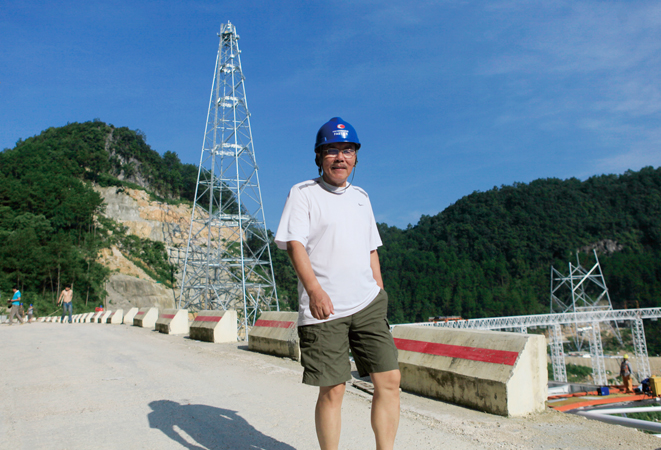By XIN Ling (Staff Reporter)

NAN Rendong, a distinguished expert in radio astronomy who is known as the father of the world’s largest radio telescope, died from lung cancer in Boston on September 15, 2017 at the age of 72.
His untimely passing away was just ten days before his masterpiece, the Five-hundred-meter Aperture Spherical radio Telescope (FAST), which he spent over two decades conceiving and building for the next generation astronomers in China and in the world, was going to celebrate its first anniversary on September 25, 2017.
According to an obituary posted on the website of the National Astronomical Observatories, Chinese Academy of Sciences (NAOC) where he used to work, as the chief scientist and general engineer of FAST, NAN was responsible for the telescope from the very beginning from its conception to site selection, pre-research, project proposal, identification of scientific goals and eight years of construction until it was completed on September 25, 2016.
The telescope he proposed in 1994 would be a unique one on Earth: with a total collecting area equivalent to the size of 30 soccer fields, FAST is the biggest and most sensitive “radio antenna” for the search of pulsars, the neutral hydrogen sky, interstellar molecules and even extraterrestrial life. Compared with the Arecibo Telescope, it is not only bigger but innovative in many ways, including a much larger sky coverage thanks to its active main reflector, and a light-weight, adjustable feed cabin to move around with high precision.
Back in 1994, the biggest radio telescopes China had were the Sheshan 25 m radio telescope at Shanghai Astronomical Observatory and the Nanshan 25 m radio telescope at Xinjiang Astronomical Observatory. NAN and his men spent nearly a decade searching in the mountains of southwestern China for a suitable spot to place such a gigantic facility, until they finally found the Dawodang depression in Pingtang, Guizhou to be the home of FAST. Then, with his expertise and perseverance, NAN led his team to overcome a number of formidable technical challenges during the construction, for instance the development of super strong cables for the unique cable-net structure of FAST so that its surface, which is made up of 4,450 aluminum reflecting segments, can transform from a spherical to parabolic shape to focus the signals.
One year after the telescope was finished and entered commissioning and test observation, FAST has been making steady progresses. “We have completed the integrated test of the adaptive reflector, the feed cabin and the wide band receiver,” said XUE Suijian, deputy director of NAOC. Meanwhile, some initial findings are coming up according to FAST project scientist LI Di. “We have identified a few high quality pulsar candidates,” LI revealed. “For example, J1859-01 is what we discovered with FAST during a drift-scan observation of the southern sky galactic plane last month, on August 22. It has a rotation period of 1.83 seconds and is approximately 16,000 light years away from us. The result has been confirmed by the 64 m Parkes Telescope in Australia,” LI told BCAS.
The NAOC obituary said that “Prof. NAN was devoted, generous, modest, sincere and selfless. He had made outstanding contributions to the development of astronomy in China.”
“NAN’s passing away is a tremendous loss to the Chinese astronomical society”, CAS President BAI Chunli wrote in his letter to NAOC. “His pioneering spirit, pursuit of excellence, and devotion to work without asking for return make him a role model for us all.”
Born in 1945 in the city of Liaoyuan, northeast China’s Liaoning Province, NAN studied radio technology at Tsinghua University between 1963 and 1968. Soon after his graduation, the Cultural Revolution prevailed in China and he had to work as a technician at a local radio factory not far from his home town. In 1978 NAN entered the Graduate School of CAS (now the University of CAS) to study radio astronomy and earned his PhD in 1987.
During his research career first at the Beijing Astronomical Observatory and later at NAOC, NAN was not only well known to the domestic community but also very active internationally. He was a visiting scientist in the Netherlands and Japan in the 1980s and 1990s. He played a key role in initiating the Sino-Dutch partnership in radio astronomy, as well as China’s participation in the European Very Long Baseline Interferometry (VLBI) project. Between 2006 and 2009 he served as President of Division X Radio Astronomy of the International Astronomical Union.
NAN has been highly respected for his achievements around the world. “I’ve known him for many years and have always admired his courage and stamina in taking the FAST telescope from conception to completion,” said Dick Manchester from the Commonwealth Scientific and Industrial Research Organisation (CISRO) in Sydney, Australia.
“We were shocked and very saddened to learn that Dr. NAN passed away last week,” wrote Sandra Faber from the University of California, Santa Cruz in her email to the NAOC leadership. “Completion of the world’s largest radio telescope by Dr. NAN and his team is a stunning technical achievement and is a strong tribute to his vision and to extraordinary teamwork by the entire Chinese astronomical community.”
Hideyuki Kobayashi, vice director-general of the National Astronomical Observatory of Japan and NAN’s old friend, extended his sympathy to NAN’s family. He and NAN first met at the Bologna VLBI summer school in 1988, and had collaborated in the field of VLBI research in Asia. “He was an extremely tough guy for the astronomy and made a great achievement to make FAST a reality. I heard it was very difficult work and he did it. Definitely he was the leader of the FAST project. He is an honor for Chinese astronomy and his family as well,” said Kobayashi.
“NAN was a true visionary of radio astronomy, and it is only fitting that his legacy will remain in the FAST antenna,” commented Martha Haynes from Cornell University in her condolence message to NAOC.
NAN was popular also because of his outgoing and upfront personality. Tony Foley from the Netherlands who worked with NAN in the 1980s remembered him as “always cheerful and a pleasure to work with.”
“He was always thoughtful and someone with whom there always was a strong resonance for me with so many things to share, scientific and otherwise”, recalled Prajval Shastri from the Indian Institute of Astrophysics. “The learning from his life's experiences that he sometimes talked about was unique in so many ways, and he brought a special combination of playfulness and wisdom to his interactions that will always stay with me… FAST is a phenomenal scientific legacy that he has left behind, but even more, there is the intense warmth and laughter with which Rendong touched so many of our lives.”
NAN had been fighting against lung cancer for the last couple of years of his life. According to NAOC, he was in Boston seeking treatment when he contracted lung infection and his health worsened suddenly.


